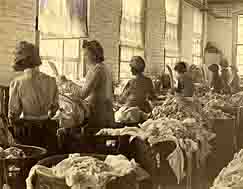industrialization & immigration
Irish Immigrants in Holyoke
Directors of the Hadley Falls Company envisioned an industrial center to rival the production of mill towns in the eastern part of the state. In 1848, construction began on a dam and a system of canals to provide water power to mills and factories producing everything from paper and textiles to steam boilers, cutlery and wire. Irish immigrants provided the bulk of the labor that built the canals, and the developing industrial center became known locally as "the Ireland Depot."
Mill towns presented employment opportunities for new immigrants, but those who arrived poor and unskilled typically began at the bottom of the socioeconomic ladder. The Irish in particular faced hostility and discrimination from native-born residents because of their generally low level of education and impoverished living conditions. In 1850, directors of the Hadley Falls Company renamed the town Holyoke in order to combat growing animosity towards "the Irish Parish."
As a group, the Irish were regarded as "backward" and good only for menial labor. That stereotype was reinforced by the fact that recent Irish immigrants to Holyoke lived in one-room shanties located near the factories, in an area known as ""The Patch," near present-day Prospect Park. An Irishman who developed certain skills to better his economic situation or was able to purchase a plot of land in another part of the city and build a more permanent structure for his family was often regarded as an interloper or competitor for jobs that belonged to "Americans." To make matters worse, the Irish were Catholics, and their very presence presented a challenge to those nativists who regarded the United States as a Protestant country.
The Irish immigrant experience during the nineteenth century contrasted with that of German and, later, French-Canadian immigrants. The smaller German community in the Connecticut River Valley was generally better-educated, more prosperous and better assimilated. As upwardly mobile Protestants, German immigrants shared crucial cultural traits with an American society transformed by economic expansion. French-Canadians, drawn to Holyoke by millwork, were upwardly mobile as craftsmen and settled in tightly-knit communities with ties to the home country. Even though the Irish arrived first, French-Canadian immigrants regarded the Irish with condescension. Language and lifestyle differences, exacerbated by a sense of labor competition, created hostilities that at times erupted into street fights between Irish and French-Canadian workers.
As a result of public perception and a difficult assimilation process, most Irish immigrants found themselves living in slums marked off by ethnic boundaries. Local Catholic churches played a crucial role in uniting the burgeoning Irish community. St. Jerome's Church, organized by the Springfield diocese in 1856, provided a haven for the practice of religious devotion that, in turn, ignited a strong Irish nationalist movement. Meeting halls opened to provide public space for the developing sense of community, and a local branch of the Irish Emigration Society undertook to educate and assimilate recent arrivals.
Religion and the animosity of nativists and other immigrant groups inspired a sense of identity and solidarity that sustained Irish-Americans as they created local communities and eventually escaped poverty and discrimination for the social and economic mainstream. The Irish experience illustrates the path taken by many poor immigrants, from denigration and separation to yet another distinctive thread in the colorful mosaic that is U.S. society. Perhaps nowhere is the Irish legacy more apparent than the Holyoke Saint Patrick's Day parade, which originated in 1952 and continues to the present. The parade has become not only a celebration of Irish ancestry, but recognition of Holyoke's proud tradition as a village built by immigrants.